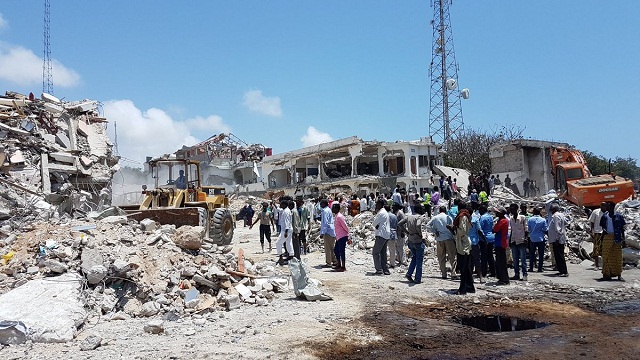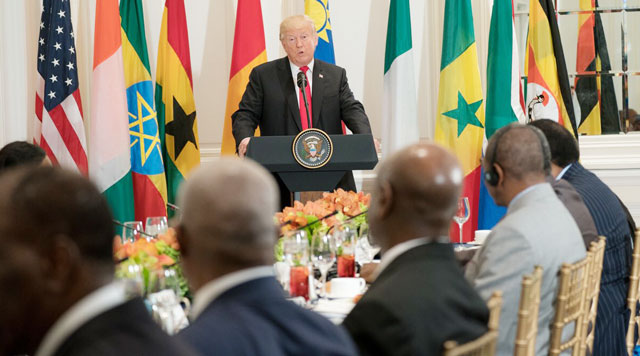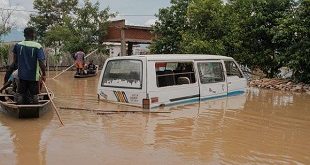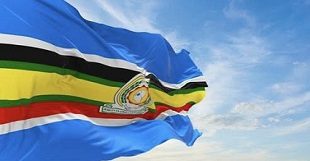
Trump’s strategy and 5 factors around Mogadishu killing of 300
Kampala, Uganda | HAGGAI MATSIKO, IAN KATUSIIME, JULIUS BUSINGE | October 20| Hundreds of dead were burnt beyond recognition. One mother lost all her nine children. Wives, husbands, children and whole families perished in the Oct.14 bomb attack in Somalia capital, Mogadishu, whose death toll had reached 300 within two days. 300 others were reeling from injuries.
“Everywhere you looked, there were dead bodies,” Abdulkadir Abdirahman, the director of Mogadishu’s ambulance service told Al Jazeera, soon after the attack, “The tarmac was covered in flesh, blood, and pieces of clothes.”
In one of the burned minibuses were children coming from school, he added, their charred remains tangled in what was left in the vehicle they were travelling in.
“Our country has never seen anything even close to this,” he added.
Senator Abshir Ahmed said in a Facebook post that the attack was the deadliest incident he remembers since the 1990s, when the government collapsed.
Somali president, Mohamed Abdullahi Mohamed, declared three days of national mourning. He said the horrific attack “proves our enemy would stop at nothing to cause our people pain and suffering.”
The attack is a major setback for Somalia, which has been pounded by militants for the last 25 years. But as international and regional security experts analyse ways to avert future attacks, fingers are pointing at probable contributing factors to attacks.
Targeting Trump’s policy
The timing of the attack has been a point of much talk, happening as it did when the U.S. was intensifying its activity is Somalia. In April, President Donald Trump authorised the deployment of U.S. soldiers to Somalia for the first time since 1994.

The deployment brought back memories of 1993 when Somali militiamen shot down two American Black Hawk helicopters, killed 18 American marines, and forced then-President Bill Clinton to withdraw U.S. troops in March 1995.
But following the April deployment, the head of the U.S Africa Command (Africom), Gen. Thomas Waldhauser had just visited Mogadishu on Oct.12 and met with Somalia’s President Mohamed Abdullahi Mohamed. Gen. Waldhauser was last in Mogadishu on April and met again with President Mohamed. Shortly after that, in May, a U.S. Navy SEAL was killed and two troops during attack on an Al Shabaab base.
Then on June 11, the U.S launched its first offensive attack against the Al Shabaab in Somalia under new relaxed rules of engagement authorised by President Trump. Africom said 8 Al Shabaab were killed in the attack. Since then Africom has launched almost weekly attacks on the Al Shabaab. A July 29 strike is said to have killed Sheikh Ali Jabal; the self-styled Al Shabaab governor of Mogadishu. The latest was on Sept.01 and killed Al Shabaab commander Abu-Xudeyfi in Barawe Southern Somalia.
According to the Long War Journal, U.S. Special Operations forces have launched 15 airstrikes against Shabab leaders, fighters, and training camps since the beginning of the year. Five strikes were launched in September alone.
Under the previous administration of President Barack Obama, U.S troops were allowed to use lethal fire only in defensive situations in Somalia. Trump has also apparently relaxed rules on and increased the use of drones in Somalia outside of declared warzones and even when there is a high likelihood of civilian casualties. A ground attack involving U.S. forces on Aug. 25 killed 10 civilians, including 3 children on a farm in Bariire, in Somalia’s southern Lower Shabelle region. The attack in Mogadishu is, therefore, being seen as retaliation for the ratcheting up of U.S. offensive activity against Al Shabaab.
President Trump has set defeating radical Islamic terror groups as a major goal. But observers say, the deployment of U.S. troops in Somalia opened them up to manipulation in complex local clan fights. It is alleged, for example, that in September 2016, security forces in the semi-autonomous state of Puntland asked the U.S. to strike alleged Al-Shabab, but after 10 were killed, it emerged that they were not al-Shabaab but opponents of the government.
 The Independent Uganda: You get the Truth we Pay the Price
The Independent Uganda: You get the Truth we Pay the Price


